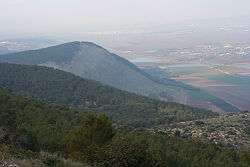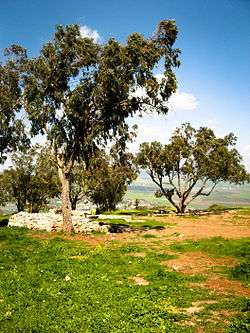Mount Gilboa


Mount Gilboa (Hebrew: הר הגלבוע Har haGilboa), sometimes called the Mountains of Gelboe, is a mountain range overlooking the Jezreel Valley in northern Israel. The meaning of the name Gilboa is boiling springs; bubbling fountains; agitated pools; water bursting from the rock, which makes it similar to the Arabic name "Jebel Faqqua" ("jebel" means mountain, "faqqa" means burst, split).[1]
In the Bible
In the Bible, King Saul, Israel's first King, led a charge against the Philistines at Mount Gilboa (1 Samuel 28:4).[2] The battle ends with the king falling on his own sword and Saul's sons, Jonathan, Abinadab, and Melchishua being killed in battle (1 Samuel 31:1-4). David, who hears about the tragedy after the battle, curses the mountain: "Ye mountains of Gilboa, let there be no dew nor rain upon you, neither fields of choice fruits; for there the shield of the mighty was vilely cast away, the shield of Saul, not anointed with oil" (2 Samuel 1:21).
History
A minor battle between the army of the Crusader Kingdom of Jerusalem and Sultan Saladin took place at the foot of Mount Gilboa in 1183.
The 1260 Battle of Ain Jalut was fought at the foot of Mount Gilboa. The success of the Muslim Mamluks against the Mongols marked the end of the westward push of the Asian empire and ensured the survival of Muslim Egypt.
Geography
The formation has the shape of a boomerang, extending north from the highlands of Samaria on the West Bank and turning northwest at about half its length, thus separating the southeastern end of the Jezreel Valley from the Beit She'an and Ein Harod valleys. The Green Line between Israel and the West Bank runs south and west of the ridge. The range's highest peak rises 1629 feet above sea level.
Flora and fauna
.jpg)
In 1976 and 1977, it was counted to have about 170 plant species, including pinus halepensis (on the rocky slopes) and Pistacia lentiscus (the shrub layer).[3]
Every year from late February until late March the purple Hayne's Iris, known in Hebrew as the Gilboa Iris (Irus ha-Gilboa), blooms on the mountain.[4] Two nature reserves have been declared on the ridge: the Gilboa Iris nature reserve in 1970, covering 7,280 dunams (728 ha), and the eastern Gilboa reserve in 2005, covering 18,290 dunams (1,829 ha).[5]
It also has a very diverse in animal species range, with 14 reptile, 7 rodent, 31 bird and 13 isopod species.[6]
See also
- Gilboa Regional Council
- Ma'ale Gilboa - a religious kibbutz on Mount Gilboa
- Malkishua - a drug rehabilitation centre on Mount Gilboa
- Meirav - a religious kibbutz on Mount Gilboa
References
- ↑ .meaning Gilboa
- ↑ Julie Baretz The Bible on Location: Off the Beaten Path in Ancient and Modern Israel, p. 78, at Google Books
- ↑ G. M. Woodwell The Earth in Transition: Patterns and Processes of Biotic Impoverishment (1990), p. 287, at Google Books
- ↑ Samantha WilsonIsrael, p. 203, at Google Books
- ↑ "List of National Parks and Nature Reserves" (PDF) (in Hebrew). Israel Nature and Parks Authority. Retrieved 2010-09-27.
- ↑ Zev Nave Transdisciplinary Challenges in Landscape Ecology and Restoration Ecology, an Anthology (2007), p. 148, at Google Books
| Wikimedia Commons has media related to Mount Gilboa. |
Coordinates: 32°26′02″N 35°24′52″E / 32.43389°N 35.41444°E